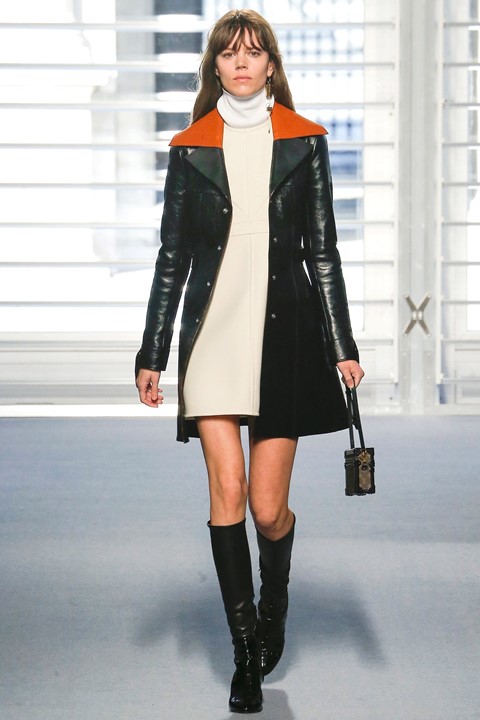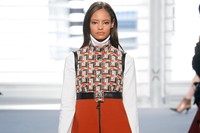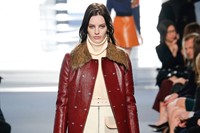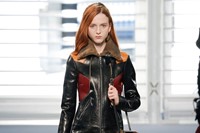As Ghesquière was due to co-chair this year’s ‘About Time’-themed Met Gala this week, we look back at Louis Vuitton’s A/W14 collection, his debut at the house
In any normal year, the first Monday of May means the Met Gala, the annual ‘Oscars of fashion’ which heralds the opening of the Costume Institute’s spring exhibition at New York’s Metropolitan Museum of Art. Had all have been well, the French fashion designer Nicolas Ghesquière – currently artistic director of womenswear for Parisian house Louis Vuitton, and before that, creative director of Balenciaga – would have been co-chair of this year’s event, originally due to take place this week, alongside the actors Meryl Streep, Emma Stone and Lin-Manuel Miranda (and likely dressed his usual high-profile coterie of stars for the occasion).
But 2020 is, of course, no normal year: as the coronavirus pandemic continues to disrupt the world, the Met Gala was cancelled, replaced with a virtual event A Moment With the Met hosted by American Vogue editor Anna Wintour on Monday evening. The news was not all bad, though – the exhibition itself, titled About Time: Fashion and Duration, will go ahead, opening this October. Curated by Andrew Bolton, About Time will see garments from 1870 to the present day compared across eras to provide what the museum calls a “disruptive timeline” of fashion on the museum’s 150th anniversary. For example, a men’s embroidered jacket, created at the beginning of the 20th century but referencing menswear of the 18th, might be displayed next to a Ghesquière-designed jacquard waistcoast from a Louis Vuitton collection created in 2018, inspired by France’s ancien régime.
The exhibition’s theme made Ghesquière a fitting co-chair for the event – at Vuitton, and Balenciaga before that, the designer has created collections with a “disruptive timeline” all their own. At Vuitton in particular, his clothing is a dizzying melting pot of eras and juxtapositions – for Spring/Summer 2018, for example, he sent out models in Louis XIV frock coats with silk boxer shorts and space age trainers – and contain myriad pop culture references, from motocross riders to 70s sci-fi. This season – in the final show of Paris Fashion Week, and thus perhaps the last physical fashion show we will see for some time – he backgrounded his collection with an operatic chorus of men and women each uniquely dressed in historical garb from the 15th century to 1950. “I wanted different eras to be confronted with another one, our own,” he said at the time.
“At Louis Vuitton, fashion and time have been in constant dialogue for over 150 years,” Ghesquière had elaborated at a launch event for About Time earlier this year. “And the rapport between those two elements remains fundamental to my work. I have always looked to marry silhouettes, techniques, memories, and impressions from the past with the latest technology to create fashion for today that speaks to the future.”
Those elements have been central in Ghesquière’s work since the very beginning of his tenure at Louis Vuitton. His story at the historic house began with a debut collection shown in Paris for the Autumn/Winter 2014 season, which saw the designer re-present Vuitton’s heritage with new clarity and focus, moving away from the theatrics of previous artistic director Marc Jacobs. It was heralded by Suzy Menkes at the New York Times as a success, “for its modernity, its clarity, its decency – and its respect for women”. Half a decade on, we look back at this landmark collection, which marked a “new day” for Louis Vuitton.
The Show
Anticipation was high for the show, which took place on the final day of Paris Fashion Week at the Louvre’s Cour Carrée (“you can feel the energy in the room,” said Anna Wintour prior to its start). Foregoing the elaborate sets of his forebear, Marc Jacobs – who had been known to conjure moving trains and vast escalators, hotel corridors and merry-go-rounds – the space was sparse, with simple blocks of white seating, and shuttered blinds around its edges. As the show began, they opened, and let in the light. “Today is a new day. A big day,” read a message from Ghesquière left on each seat. “Words cannot express exactly how I am feeling at this moment ... The quest for authenticity and innovation. The desire for timelessness. Does not every designer ultimately seek to create something timeless?”
The look was streamlined, and defiantly modern – though the collection’s defining silhouette borrowed from the abbreviated A-line of the 1960s. Unsurprisingly, leather and suede were in abundance, cut with the kind of architectural clarity that Ghesquière is known for (he is a devoted fan of Modernist architecture, and his clothing often borrows similarly geometric lines). Skirts were sharp and short, kicking out towards the hem, while leather outerwear was leaner, pinching at the waist with a V-shaped torso, and finished with pointed coloured or shearling collars. A sportier note was struck in zip-up high-necked sweaters and slick racer-leather pants; while girlish details lent a sense of femininity, whether frilled blouses or the accentuated cups on leather slip dresses.

The People
“Emotions were high in the crowd,” wrote American Vogue’s Nicole Phelps of the occasion, which saw the fashion industry gather en masse to celebrate one of its most lauded figures. “Few designers are as beloved, respected, or copied as Ghesquière is, and he’s been off the scene and badly missed since his departure from Balenciaga a year and a half ago. Only Raf Simons’ debut at Dior was as breathlessly anticipated as Ghesquière’s at Vuitton.”
Attendees – who spanned the worlds of fashion, art, film and royalty – included the artist Cindy Sherman, the actress Chlöe Sevigny, and Charlene, Princess of Monaco. Jean Paul Gaultier, the designer who Ghesquière worked with prior to his appointment at Balenciaga, also watched on. Other designers in attendance included Ghesquière’s contemporaries Jonathan Anderson, Phoebe Philo and Kim Jones, then the creative director of the house’s menswear.
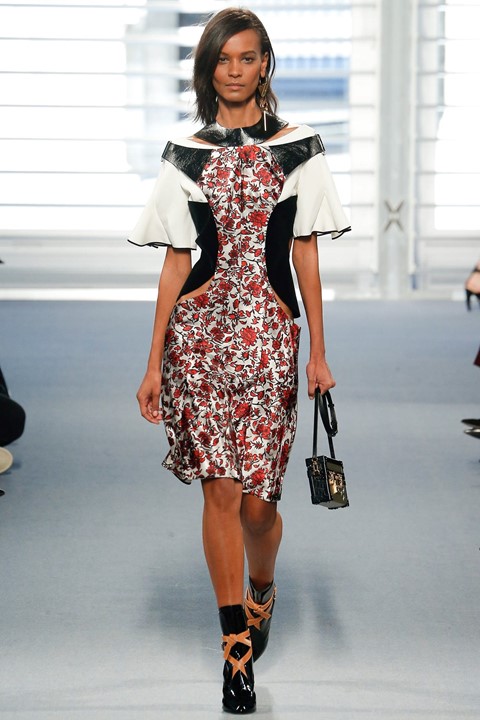
The Impact
We are perhaps too close to the event to see the absolute influence of Ghesquière’s tenure at Louis Vuitton – after all, the designer remains at the house and looks to be there for the foreseeable future (in 2018 he signed a new contract with parent company LVMH which, though the exact details were not released, was rumoured to be another five years due to the “unprecendented growth” under his leadership thus far). However, what his first collection established is the house “codes” which Ghesquière continues to expand upon today.
There was the introduction of the ‘Petit Malle’, a miniscule version of the house’s signature trunk made to be held in the hand – or indeed swing from it, as Freja Beha Erichsen demonstrated in the collection’s opening look – and replete with the house’s signature monogrammed leather and tumbler lock. Since, the bag has appeared in myriad versions, from numerous different fabrications to a smaller version to encase an iPhone, and inspired a whole range of esoteric leather accessories, including the much-coveted ovoid ‘egg’ bag from Spring/Summer 2019.
But the collection also put the unique savoir faire of the house’s leather atelier at Vuitton’s Asnières-sur-Seine property front and centre of the collection – which Ghesquière continues to use to push his work in unexpected new directions. It was perhaps the first glimpse of his ability to approach centuries-old craft with the rigorous precision of modern architecture, breathing new life into the fabric which has been at the heart of Louis Vuitton since its very beginnings.
